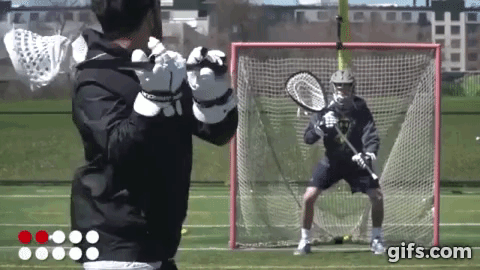Lacrosse balls are shot from the lacrosse stick at a high rate of velocity. The velocity that comes from the stick renders a high rotation of the lacrosse ball.
The best example of this is when a lacrosse ball is thrown (whether by hand or by stick) and the lacrosse ball hits the ground the first time; it picks up speed and propels itself at greater speeds the second time it touches the ground. This spin creates movement within the ball as it’s launched forward.
Lacrosse shots can be curved. The ball needs to be launched at high speed and curved speed to create the rotation necessary to curve the lacrosse ball.
Lacrosse balls, due to the material they’re made of, naturally create a rotation when thrown.
We’re going to show you how to curve a lacrosse ball and how it’s possible.
Can You Curve A Lacrosse Ball?
Yes. There needs to be a lot to happen for the ball to curve successfully.
Take a baseball, for instance; to curve the baseball; the ball needs to be spun out of the pitcher’s hand at an angle that can work against the wind resistance. As the ball travels through the air, it fights wind resistance, pushing air against the ball, which gives it the dramatic drop, as seen in this video.
A lacrosse ball is no different from a baseball. The same physics applies to the as it does baseball.
The most obvious difference between the two is one is thrown with a hand (which is easily manipulated), and one is thrown with a stick. A player must have the proper launch angle to battle gravity and wind resistance to curve a lacrosse ball successfully.
In the video above, the players are testing the flight pattern, and as we can see, there’s some slight curve ( not much) from the sidespin put on the ball as it leaves the stick.
On a normal overhand throw, the ball will create natural backward rotation. The ball that is spinning backward is naturally going to stay straight and have a slight drop. This is due to the bottom of the ball fighting the wind resistance.
This is shown in Paul Rabil’s tutorial below on throwing a lacrosse ball. Notice how the ball leaves his stick, and the head of the lacrosse stick creates natural backspin for the ball. This would be similar to throwing a 4-seam fastball in baseball.
Curving a lacrosse ball on angled throws is a bit different. Detailed in our earlier example, this would be similar to throwing a curveball in baseball.
As shown in the example below, players will often drop to a side slot to throw the lacrosse ball, where the side-wards spin can occur.

The deciding factor is in the release. The player would need to turn his stick at the last second upon release to create a spin on the ball that would fight sideways against the wide resistance and have a mild curve effect.
This, of course, would be incredibly hard to accomplish but is possible to do. It also depends on if the ball has dimples or engravings, which can also help the ball’s movement and flight path.
A baseball and tennis ball has grooves and dimples, which alter its pattern when fighting the wind. This is what gives it its alternate flight pattern.
In simpler terms, if you’ve ever thrown a whiffle ball, you know that it’s tough to locate a ball because the wind is always fighting against it.
Lacrosse balls don’t always need rigid surfaces to change direction. If you’re familiar with ping pong, players create slices and draw with a lightweight ball but a smooth surface.
Because of the lacrosse balls’ density and smooth surface will take higher velocity and the right angle to make it curve. It’s Not easy to do, however not impossible to do neither.
See Our Complete List Of Helpful Lacrosse Articles Here.
Speed To Curve A Lacrosse Shot
To put in perspective, the fastest lacrosse shot ever recorded is by Patrick Luehrsen, on September 29, 2015, which was recorded at 192.96 Kilometres (or 119.9 MPH). Here’s the video:
This, of course, is the fastest shot ever recorded, not how fast a normal, in-game lacrosse shot is launched off the stick.
The average lacrosse shot can be anywhere between 75-82 MPH. This is, of course, if the player has no obstacles in front of them and they’re taking a full wind up to the net. This also varies based upon player size and how close they are to the net.
Typically, players run on one foot or even in the air when they sling the lacrosse ball toward the net.
This high rate of speed is needed in order to curve a lacrosse shot properly. The ball needs to be released from the net at a high rate of speed, which can then be manipulated through the air.
Conclusion
Lacrosse shots can be curved if a tremendous amount of force is applied to the ball upon release. Although it is uncommon for a player to deliver a ball that drastically curves, it is possible based on simple physics.
It is extremely hard to curve a lacrosse shot. Instead, we recommend learning how to shoot the ball accurately at a high rate of speed and learning to bounce the ball in front of the goalie.
Bouncing the ball is a harder shot for the goalie to save because he needs to track where the ball is, as well as the flight path after it’s been bounced. Trying to track the ball at a high rate of speed is much harder for the goalie to track.
If you have some spare time, try to learn how to curve the lacrosse ball. Study its flight pattern simply by spinning your wrists at the end of the throw.
Do you have video of curving a lacrosse ball? Let us know in the comments if you’ve had success in moving the lacrosse ball after release.
